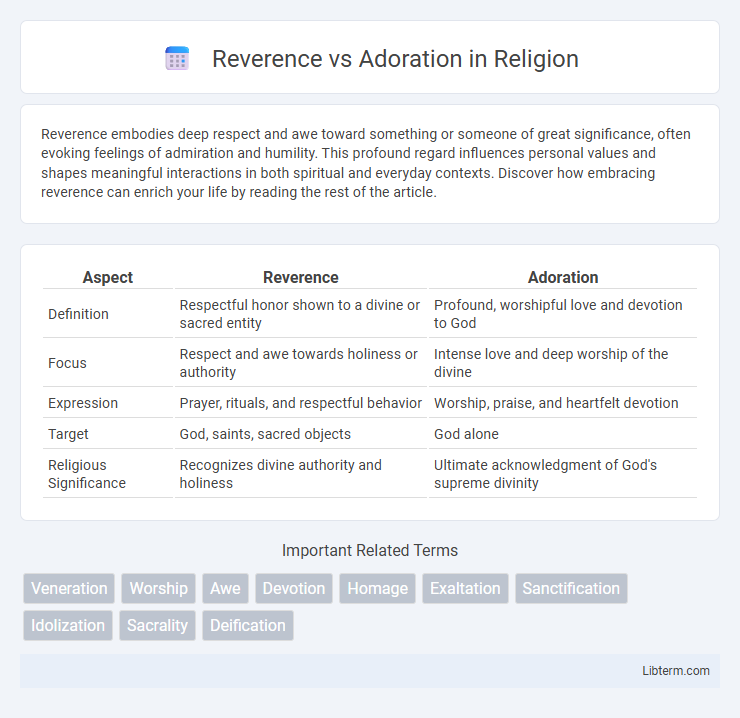Reverence embodies deep respect and awe toward something or someone of great significance, often evoking feelings of admiration and humility. This profound regard influences personal values and shapes meaningful interactions in both spiritual and everyday contexts. Discover how embracing reverence can enrich your life by reading the rest of the article.
Table of Comparison
| Aspect | Reverence | Adoration |
|---|---|---|
| Definition | Respectful honor shown to a divine or sacred entity | Profound, worshipful love and devotion to God |
| Focus | Respect and awe towards holiness or authority | Intense love and deep worship of the divine |
| Expression | Prayer, rituals, and respectful behavior | Worship, praise, and heartfelt devotion |
| Target | God, saints, sacred objects | God alone |
| Religious Significance | Recognizes divine authority and holiness | Ultimate acknowledgment of God's supreme divinity |
Defining Reverence and Adoration
Reverence is a profound respect and veneration directed toward someone or something deemed sacred or worthy, often characterized by humility and awe. Adoration intensifies this sentiment, signifying an intense love and deep devotion typically reserved for divine beings or highly esteemed figures. While reverence implies respectful honor, adoration conveys passionate worship and affection.
Historical Contexts of Reverence and Adoration
Reverence historically emerged as a profound respect for authority, tradition, and sacred institutions, often manifesting in rituals and ceremonies across cultures. Adoration, rooted in ancient religious practices, signified deep love and worship toward deities or revered figures, exemplified by early Egyptian and Greek civilizations. Both concepts evolved within societal frameworks to reinforce social hierarchies and spiritual devotion, shaping collective cultural identities over centuries.
The Emotional Nuances: Reverence vs Adoration
Reverence embodies a deep respect and awe that inspires humility and solemnity, often linked to spiritual or philosophical recognition of something greater than oneself. Adoration conveys intense love and devotion, characterized by warmth, affection, and emotional closeness, typically directed toward a beloved person, deity, or cherished ideal. The emotional nuances distinguish reverence as respectful and contemplative, while adoration reflects passionate and affectionate engagement.
Cultural Perspectives on Reverence and Adoration
Cultural perspectives on reverence and adoration vary significantly, with reverence often linked to respect for tradition, authority, or nature, evident in Eastern philosophies such as Confucianism and Shintoism. Adoration is frequently associated with intense emotional worship or devotion, prominently seen in religious practices like Mediterranean Catholicism and Hindu Bhakti movements. These distinctions highlight how different societies prioritize either solemn respect or passionate devotion based on their historical, religious, and social contexts.
Religious Interpretations: Worship, Reverence, and Adoration
In religious interpretations, worship encompasses acts of reverence and adoration directed toward a divine entity, reflecting deep respect and devotion. Reverence involves a profound acknowledgment of the sacredness, often expressed through rituals and prayer, emphasizing humility and veneration. Adoration, particularly in Christian traditions, signifies an intense love and heartfelt worship often reserved exclusively for God, highlighting the believer's intimate and passionate connection to the divine.
Psychological Foundations: Why We Revere and Adore
Reverence and adoration stem from distinct psychological foundations that shape human emotional responses and social behaviors. Reverence is rooted in respect and awe for qualities such as wisdom, virtue, and authority, often linked to moral and cognitive appraisal processes that emphasize admiration without personal attachment. Adoration, by contrast, involves deep emotional attachment and idealization, reflecting a psychological drive for connection, affection, and transcendence beyond ordinary experience.
Reverence and Adoration in Everyday Life
Reverence involves deep respect and honor towards people, objects, or traditions that hold significant value, often demonstrated through mindful actions and thoughtful acknowledgment. Adoration is characterized by intense love and admiration, frequently expressed through passionate devotion or praise, enhancing emotional connections in daily interactions. Both reverence and adoration enrich everyday life by fostering meaningful relationships, promoting gratitude, and encouraging a profound appreciation for the world around us.
Comparing Attitudes: Respect, Reverence, and Adoration
Respect involves acknowledging the value or qualities of a person or concept with an attitude of consideration and regard, often based on social or moral norms. Reverence goes deeper, combining respect with awe and a profound recognition of the intrinsic worth or sacredness of someone or something. Adoration surpasses both by embodying intense love, devotion, and veneration, often directed towards a deity or an object of supreme importance, reflecting an emotional and spiritual commitment.
The Impact of Reverence and Adoration on Relationships
Reverence fosters deep respect and trust, creating a stable foundation for healthy relationships by valuing boundaries and individuality. Adoration intensifies emotional connection through admiration and passionate affection, often enhancing intimacy and bonding between partners. Both reverence and adoration contribute uniquely to relationship dynamics, with reverence supporting mutual respect and adoration fueling emotional closeness.
Fostering Reverence and Adoration in Modern Society
Fostering reverence and adoration in modern society involves cultivating deep respect for cultural traditions, spiritual beliefs, and natural wonders through education and community engagement. Encouraging mindfulness practices and rituals helps individuals connect emotionally and spiritually, enhancing their appreciation for the sacred aspects of life. Promoting public art, ceremonies, and shared experiences supports the development of collective reverence and adoration, strengthening social bonds and cultural identity.
Reverence Infographic

 libterm.com
libterm.com